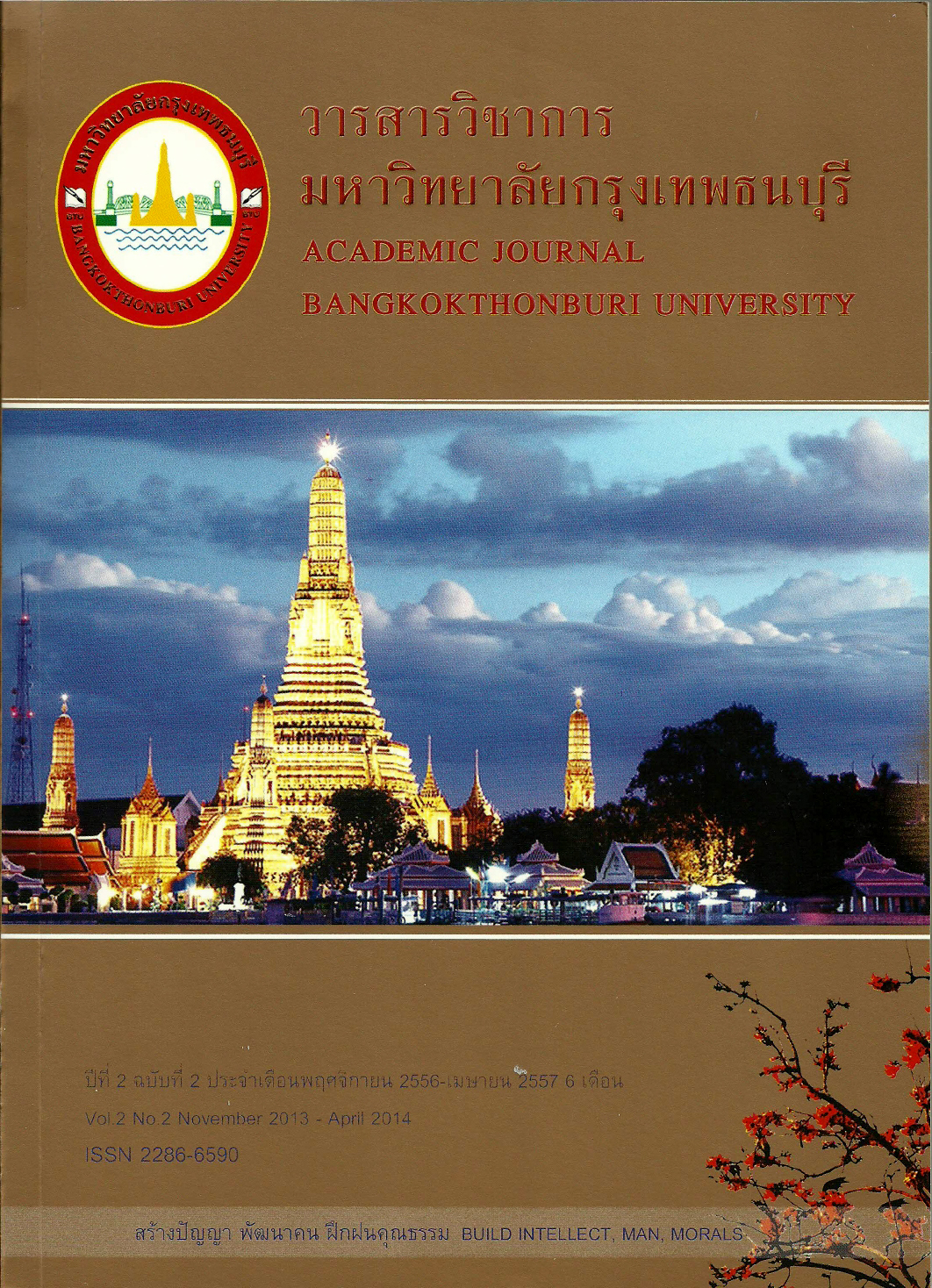การพัฒนาตัวแบบปัจจัยที่มีอิทธิพลต่อประสิทธิผลของโรงเรียน ระดับมัธยมศึกษา ภาคใต้ตอนบน
Main Article Content
Abstract
การวิจัยครั้งนี้มีวัตถุประสงค์เพื่อ (1) ศึกษาระดับการรับรู้ประสิทธิผลของโรงเรียนระดับมัธยมศึกษา (2) พัฒนาตัวแบบปัจจัยตรวจสอบความสอดคล้องกลมกลืนของตัวแบบปัจจัยที่มีอิทธิพลต่อประสิทธิผล ของโรงเรียนที่ผู้วิจัยพัฒนาขึ้นกับข้อมูลเชิงประจักษ์ กลุ่มประชากรเป็นโรงเรียนระดับมัธยมศึกษา ภาคใต้ ตอนบน จำนวน 300 โรงเรียน และกลุ่มตัวอย่างเป็นโรงเรียนระดับมัธยมศึกษา ภาคใต้ตอนบน จำนวน 80 โรงเรียน โดยการสุ่มแบบหลายขั้นตอน (Multi-Stage Random Sampling)
วิธีดำเนินการวิจัยใช้ระเบียบวิธีแบบผสมอย่างเป็นตัวหลักและตัวรอง โดยใช้การศึกษาเชิงปริมาณ จากผู้ที่เกี่ยวข้องกับประสิทธิผลของโรงเรียน จำนวน 398 คน จากกลุ่มตัวอย่าง 80 โรงเรียน และศึกษา เชิงคุณภาพจากการสนทนากลุ่ม (Focus Group Discussion) ในการศึกษาเชิงปริมาณ เก็บรวบรวม ข้อมูลโดยใช้แบบสอบถาม เครื่องมือที่ใช้ในการวิจัยเป็นแบบสอบถามมาตรประมาณค่า 5 ระดับ ซึ่งมีค่าความเชื่อมั่นเท่ากับ 0.953 วิเคราะห์ข้อมูลโดยใช้สถิติพื้นฐาน ด้วยโปรแกรมสำเร็จรูปทางด้าน คอมพิวเตอร์ ส่วนการวิเคราะห์ข้อมูลเชิงคุณภาพ โดยใช้วิธีการวิเคราะห์เนื้อหาของแต่ละประเด็นของตัว แบบปัจจัย
ผลการวิจัยสรุปได้ดังนี้
1) ระดับการรับรู้ประสิทธิผลของโรงเรียนระดับมัธยมศึกษา มีค่าเฉลี่ยโดยรวมอยู่ในระดับมาก เมื่อพิจารณารายละเอียดในแต่ละตัวแบบปัจจัย พบว่า ส่วนใหญ่มีค่าเฉลี่ยอยู่ในระดับมาก มีค่าเฉลี่ย โดยรวมอยู่ในระดับมาก ซึ่งแตกต่างกันอย่างมีนัยสำคัญทางสถิติที่ระดับ 0.01
2) ผลการพัฒนาตัวแบบปัจจัยตรวจสอบความสอดคล้องกลมกลืนของตัวแบบที่ผู้วิจัยพัฒนา ขึ้นกับข้อมูลเชิงประจักษ์ พบว่า มีความสอดคล้องกลมกลืนกับข้อมูลเชิงประจักษ์ (Chi-square = 43.45 ค่าองศาอิสระ = 34 ค่า p = 0.129 ค่าดัชนี GFI = 0.982 ค่าดัชนี AGFI = 0.959 ค่าดัชนี RMSEA = 0.026 และคา่ CN = 275 ตลอดจนผูวิ้จัยไดศึ้กษาเพิ่มเติมเกี่ยวกับ ตัวแบบปจั จัยมีอิทธิพลทางตรง อิทธิพลทางอ้อม และอิทธิพลรวมต่อประสิทธิผลของโรงเรียนโดยเรียงลำดับค่าสัมประสิทธิ์อิทธิพลจากมากไปหาน้อย ดังนี้ (1) อิทธิพลทางตรง 4 ตัวแบบปัจจัยคือ ตัวแบบปัจจัยสมรรถนะขององค์การ ตัวแบบปัจจัยการจัดกระบวนการ เรียนรู้ ตัวแบบปัจจัยบรรยากาศของโรงเรียน และตัวแบบปัจจัยภาวะผู้นำทางวิชาการ (2) อิทธิพลทางอ้อม มี 3 ตัวแบบปัจจัย คือ ตัวแบบปัจจัยสมรรถนะขององค์การที่ส่งผ่านตัวแบบปัจจัยการจัดกระบวนการ เรียนรู้กับตัวแบบปัจจัยบรรยากาศของโรงเรียน ตัวแบบปัจจัยภาวะผู้นำทางวิชาการที่ส่งผ่านตัวแบบ ปัจจัยการจัดกระบวนการเรียนรูกั้บตัวแบบปจั จัยบรรยากาศของโรงเรียน และตัวแบบปัจจัยบรรยากาศของ โรงเรียนที่ส่งผ่านตัวแบบปัจจัยการจัดกระบวนการเรียนรู้ และ (3) อิทธิพลรวม 4 ตัวแบบปัจจัยคือ ตัวแบบ ปัจจัยสมรรถนะขององค์การ ตัวแบบปัจจัยการจัดกระบวนการเรียนรู้ตัวแบบปัจจัยบรรยากาศของโรงเรียน และตัวแบบปัจจัยภาวะผู้นำทางวิชาการ
Model Development Administrative Factors Affecting School Effectiveness Secondary School Level South Top
The research objectives were to (1) study of the perception level of school effectiveness (2) model development examine the goodness-of-fit of the model of administrative factors affecting school effectiveness developed by the researcher with the empirical data. the popular secondary school level south top size of 300 schools. The sample size of 80 schools under the derived by multi-stage random sampling
The mixed methods as dominant-less dominant design and parallel design were employed in this research. The popular for the dominant quantitative about study with of school effectiveness consisted of 398 directors of the basic education schools. From the sample size of 80 schools And the less dominant qualitative study was a focus group discussion Data were collected at the some time. The quantitative data were collected by means of questionnaires, The research tool for data collection was 5-level rating scale questionnaire with the Reliability 0.953 data analyzed by using description statistics with a computer program The qualitative data were analyzed through content analysis of each issue Administrative Factors Affecting School Effectiveness.
The research results were summarized as follows:
1. The perception level the mean of administrative factors and the mean of school effectiveness are in general at high level. Considering each factor in detail, this researcher found that most factors had the means in high level while those of the large schools are at high level with the statistical significance difference at 0.01.
2. Result model development examine the goodness-of-fit test of the model of administrative factors affecting school effectiveness developed by this researcher showed that the model was consistent with the empirical data (Chi-square = 43.450, degree of freedom (df) = 34, p-value = 0.129, goodness-of-fit index (GFI) = 0.982, adjusted-goodness-of-fit index (AGFI) = 0.959, root mean square error of approximation (RMSEA) = 0.026 and critical number (CN) = 275) Administrative model factors had direct, indirect and total effect on school effectiveness with the effect coefficients ranging from large to small respectively as (1) direct effect in 4 factors that are organization’s ability, learning process management, school climate, and instructional leadership. (2) indirect effect in 3 factors that are organization’s ability influencing through learning process management and school climate, instructional leadership influencing through learning process management and school climate, school climate influencing through learning process management, and (3) total effect in 4 factors that are organization’s ability, learning process management, school climate and instructional leadership.


